Structural
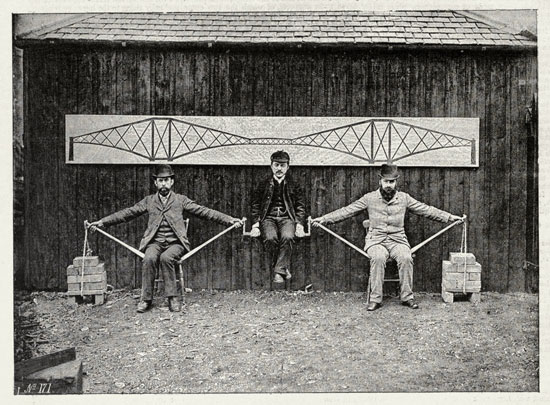
—ripple of events—
– Postcard demonstrating structural principles of the Forth Bridge
Where are the pillars of Norbiton? In what shifting sands do they plant their feet? How do they sustain our giddy, skyward brickwork?
Somewhere in the ripple of events and reflection and forgetfulness of the Ideal City, you imagine, there will be structural members, load-bearing struts and spars and trusses, braced imagined corners, attic frames, sills and lintels. A diagram of forces.
But if Norbiton: Ideal City is not so easily legible, then neither are a great many structures. When from 1420 Filippo Brunelleschi began to raise the cavernous empty dome of the cathedral of Santa Maria del Fiore in Florence above the higgeldy detail of the city and its congregations, he did so as if by conjuration, without the mechanical aid of a centring scaffold or internal bracing. The eight sides of the dome rose into nothingness, a quinto acuto converging course by course, brick upon delicate interlocking brick, an inner and an outer shell of tapering thickness and consistent cleverness.
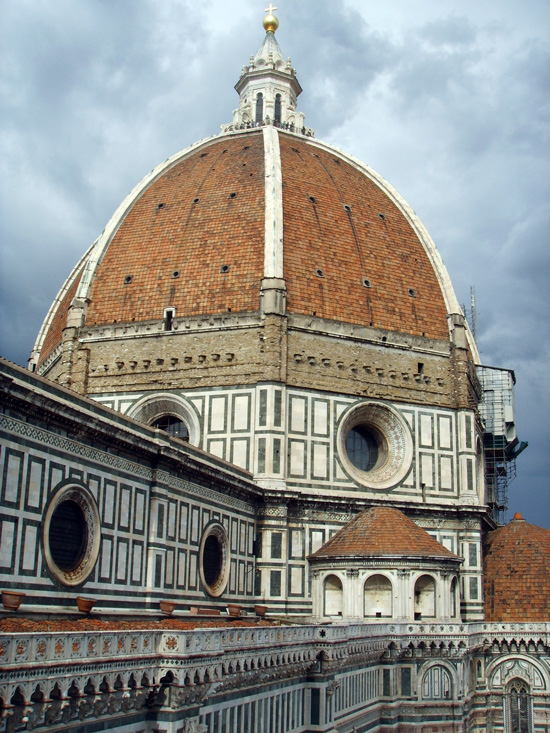
—quinto acuto—
– Dome of Santa Maria del Fiore, Florence
Photo: sailko [GFDL (http://www.gnu.org/copyleft/fdl.html), CC-BY-SA-3.0 (http://creativecommons.org/licenses/by-sa/3.0/) or CC BY 2.5 (http://creativecommons.org/licenses/by/2.5)], via Wikimedia Commons
The whole was necessarily inwrought with great structural strength, however. In order to resist the hoop stress (the deformation of the dome after loading), chains of sandstone beams and wooden beams were laid periodically around the circumference of the dome1. Each sandstone beam was seven-and-a-half feet in length and seventeen inches in section, and each weighed two tonnes. They were lifted into place by means of a great ox-hoist, the oxen below lurching around a vast capstan which drew ropes through pulleys, ropes as thick as a man’s arm, they say, which needed constant wetting as they passed through the wood of the machine lest the immense frictions set light to the whole.
And in the documents of the Opera del Duomo there is talk of an additional chain of iron to be laid atop each sandstone course. The masonry, we read, has an iron skeleton. However, magnetical searches in the 1970s, penetrating to the dense and complex body of the dome, could find no trace of any ironwork.
Perhaps it was never laid. Perhaps it was only ever an idea of strength. Which is not to say that it alone has not kept the airy, silent dome hanging there, the confusion of stresses and tensions and compressions which surround and undermine it reduced in the concealed and forgotten, perhaps only ideally present, presence of the iron to a quasi-mystical zero, the heaviness of oxen and piled brick and sandstone and the stone ribcage, the playful lightness of Florentine airs, all grappled and braced and pinioned to peaceful accord, there, invisibly, in the dark interior of the engineer’s mind.
![]()
Your life, Clarke laments wildly, is a play of forces: sheer forces and rotational forces, forces of compression, forces of tension. Why, then, does it have no structure?
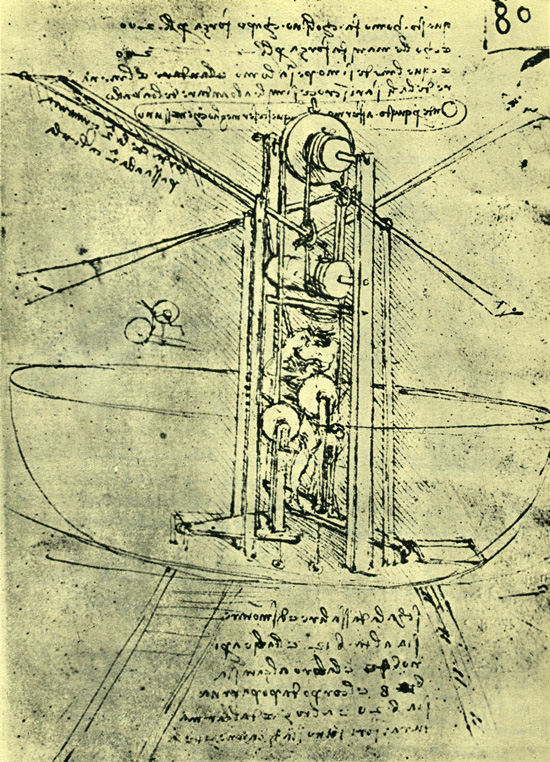
—sheer forces and rotational forces—
– Drawing of a Flying Machine with a Man Operating it
Leonardo da Vinci MS. B, fol.80 recto
We are waiting for Kelley, who has gone to fetch a lump hammer.
Clarke is half-right. Life has no structure, properly understood. No load-bearing members. When we say structure, we generally understand an arrangement of parts, or what the Renaissance would have understood as form.
But neither is life subject to forces. Clarke should go easy on himself and the agglomerations of thought which pass in his head for ideas. It does not hurt sometimes, I remind him, to think more loosely. Sub-theoretically. Sub-etymologically, even. Life has no structure, true, but we can imagine that it has its structure. We can understand it—its habits, its practices, its contracts, its voids or vacuoles of time—in structural terms. We can model it, structurally. And we can then, if we need to, calculate in imagination the play of forces: the strains on a relationship, say, or the buffets of fate, the weight of the elements themselves, the attrition of days, corrosion of beams and spars of salutary habit and good practice; and, finally, our neatly-pencilled mental calculations complete, we can optimise, or shore up, or condemn, whatever we find.
![]()
Kelley has condemned his summer-house, and we are tearing it down.
The summer-house has stood in a little-visited corner of the Kelley garden, caught in an eddy of plant-life and neglect, for twenty-five years. It is a modest wooden structure with a rudimentary porch and a pediment, wicker chairs on the porch with cushions leached to a barely-perceptible age-old chintz, and a dark interior which might once have been a pleasant retreat but where no one in these latter days ever intrudes more than an enquiring nose. The wood of the structure has not been treated for a generation and is now held together in a complex chemical interdependence of desiccation and rot. The whole edifice blisters and splits and sags.
This is the gothic structure where many years ago Kelley’s wife, Mrs Isobel Easter, conducted her affair with Hunter Sidney (Dec’d). Whether this has a bearing on Kelley’s decision, I do not know—as antique structures go, Kelley is hard to read—but Clarke and I are here to help him dismantle it, denature it, reduce it to its metamorphosed materials.
![]()
In order to identify and analyse a structure, whether real or figurative, it is first necessary to isolate and name the structured object: an atom, a cell, a life, a summer-house, a dome, an Ideal City.
Or a cosmos.
The many interior surfaces of the Nasrid Palaces of the Alhambra in the city of Granada are written over with highly-structured repetitions and redundancies in stucco and tilework: arabesques, foliate interlace, angular and mirrored polychrome patterning.
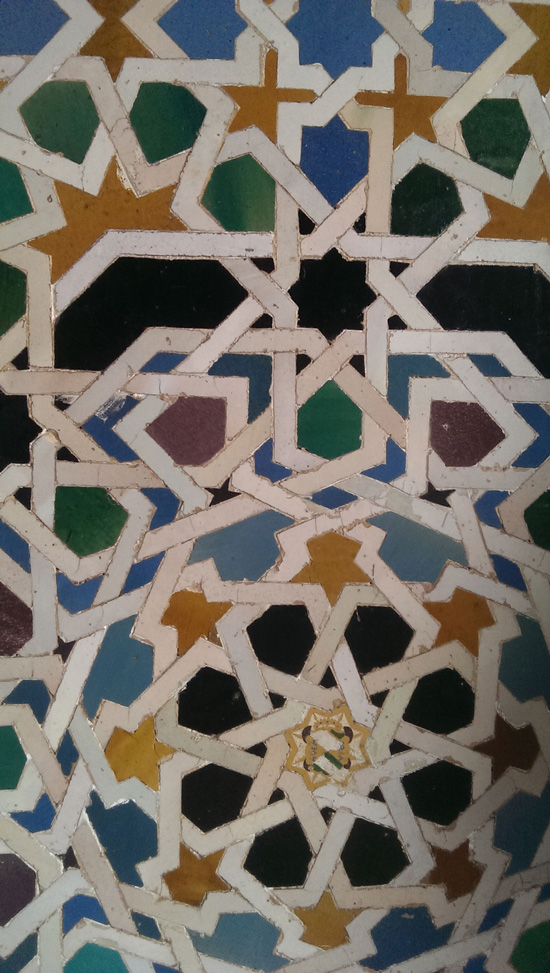
—repetitions and redundancies—
– detail of tilework, Nasrid Palaces ofthe Alhambra, Granada
I say highly-structured, but in truth it is impossible to read in the blizzard of ornamental data if what we have here is the operation of a number of classical algorithms, such that the building might be spun out to an infinite number of rooms with very little additional effort, or a more gothic freestyle invention, so that each room, each pattern, each line must be imagined and calculated afresh.
Regardless, however, of the loading of information, the effect is one of copious order in the ornamentation, an order culminating in inscription. Everywhere Kufic epigraphy springs from the decoration, ranging from formulaic ejaculations and Qur’anic verses2 to elaborate and self-satisfied poetry about the decoration itself3, of which it forms a part.
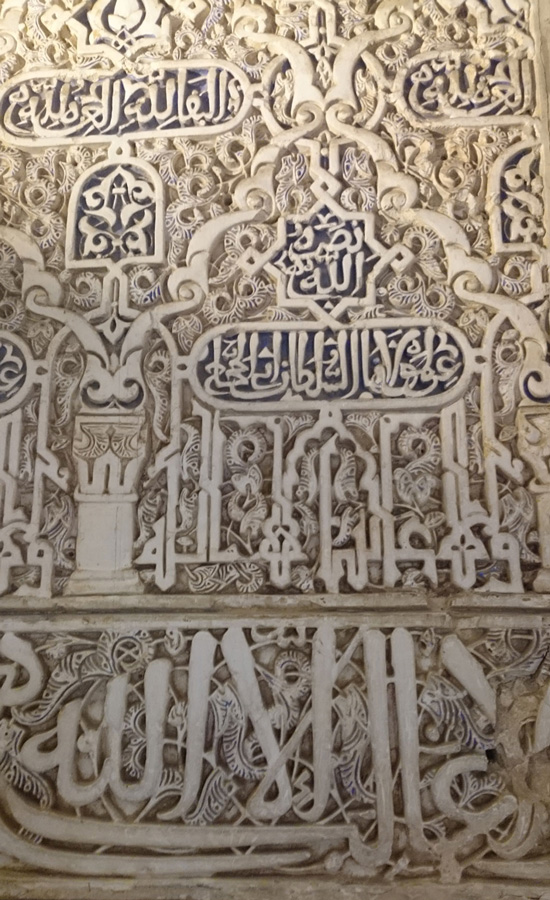
—inscription—
– detail of inscriptions, Nasrid Palaces ofthe Alhambra, Granada
To the untutored Western eye and very possibly to the tutored Medieval Arabic eye these inscriptions are nothing more than continuations of the decorative impulse: words as ornament.
But two things emerge from this decoratively verbose data set: God, a highly-structured entity worked out in repetition and mantra (there is no victor but Allah); and self, in this case the self of the building: the building is made to understand itself (the distribution of beauty) by repeatedly speculating upon its own attributes (marvels of stucco and tile).
Thus we have a glimpse of the fragile poetic sanity of the makers of the Alhambra: the constant invention and elaboration of a god and a self not so much animating principles as animated by the human gift for pattern-recognition. You do not see down, down through the surface pattern to the god or the person underneath, as Western medieval philosophers or Renaissance artists might have supposed; your god, if you own one, is the froth on the surface, a grace note to existence, a face in the arabesques.
As are you.
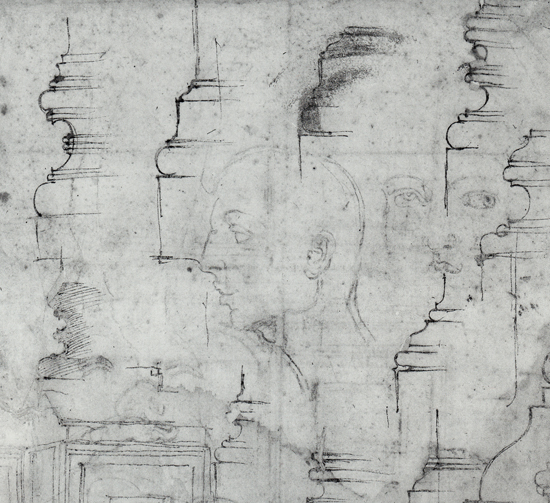
—as are you—
– studies of bases
Michelangelo
![]()
Kelley returns, and we stand looking at the summer house. The problem is not how best to begin undermining its structure, but how to do so without bringing the whole brittle engine crashing down at the first exploratory kiss of the lump hammer. Kelley goes inside to inspect. The roof, he thinks, will need to come off first. The walls will have to take their chances. The roof is heavy, narrowly sloping from a central axis, a barely-coherent object of planks and beams and cobwebs and tattered roofing felt.
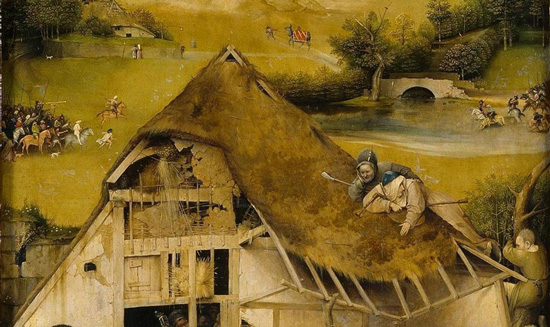
—barely-coherent—
– Adoration of the Magi, detail
Hieronymus Bosch
We are to lift it, Clarke and I, over the front wall of the summerhouse, where Kelley will take it forward; together we will shuffle it on an inch at a time, and then cant it down on to the patchy grass.
We stand and consider. It looks heavy. Could we not, Clarke ventures, get up on ladders and dismantle it bit by bit? Peel back the felt and unnail the spars and trusses of the roof? Bash it apart? But no, Kelley is all for ‘fucking it down in one go, like’, not a position you can easily encircle in argument, so that is what we do: we like fuck it down in one go.
The corners unscrewed, we lift and heave together from the inside, see where it is sticking, see where the nails are reluctant; Kelley selects his spots and thumps at them with the hammer, his contorted frame an expert (if muttering, cursing) geometry of elbows and constrained forces and efficient vectors, the curses themselves, perhaps, a necessary vector of sorts, clean little vents of psychic steam.
The roof dislodges with a sudden slight and instantly-opposed uprising; Clarke and I wobble beneath it, arms upraised in a shower of dusts and dislodged grits, and Kelley ducks outside and starts to guide us. We propel the mass forward in a series of short hops and jolts, and then pause; the centre of gravity of the roof is now equipoised over the front wall; we need to pivot the roof on the wall, but what the wall will take in the way of compression or sheer is impossible to calculate. So, still breathing heavily, we lunge it up and over its brink, and Kelley is now sustaining its weight. He puffs and blows like a circus strongman, flexing his knees and bulging his eyes, and I come out from underneath the downslanting roof and take a corner, and together we tilt and ease it down until the edge is on the grass and the whole is leaning against the front of the summerhouse. And there we pause.
![]()
I have never visited the Alhambra [as I relate elsewhere], but Veronica de Viggiani, artist and student of architecture, has, and she tells me that as a palatial structure it is impossible to read. The route laid out for tourists (and who reads the building but tourists, bewildered, mapping with cameras?) cuts like a solitary random sample through three separate palace units which would have been, in their day, incommunicable; approaches to rooms, to courts, to corridors, are haphazard, petulant, disturbed.
Perhaps, she speculates, it is intentionally disorientating. The work of the building, after all, is done across its surfaces: the highly-organised data-stream of the walls and windows and doorways and ceilings are where you simultaneously swim and drift, lose and locate yourself.
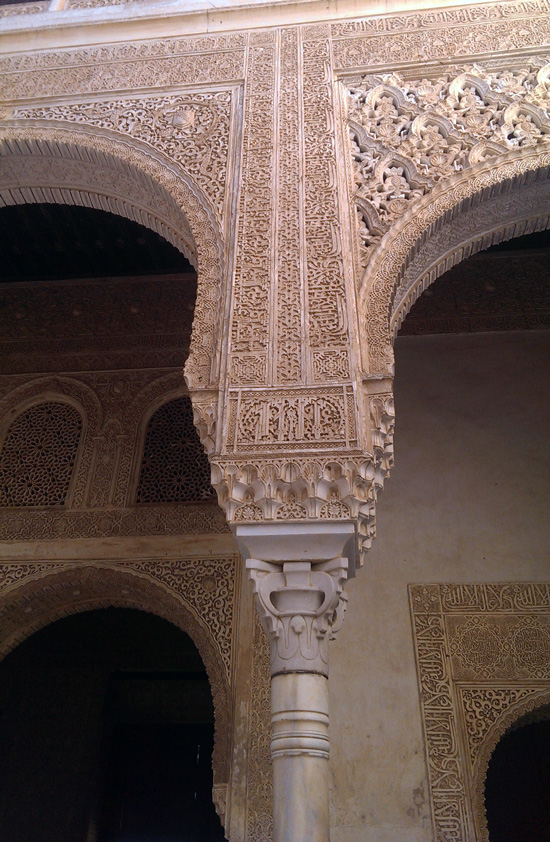
—lose and locate—
– detail of doorway, arches, Nasrid Palaces ofthe Alhambra, Granada
![]()
I may never have seen the Alhambra, but I have seen many other richly-compacted informational spaces. Take, for example, the vestibule to the Biblioteca Medicea Laurenziana, or the Laurentian Library, of Michelangelo, where the walls, as in the Alhambra, are written over.
Written over to the extent that they are not there; the walls, flat surfaces bounding an inner space, are not walls at all, but a totem of mutated classical form: niches, tabernacles, recessed columns, corbels, walls not walls but dark sinews, flexed joints, muscular upthrusts; the interior, it might be, of a massive, thinking body.
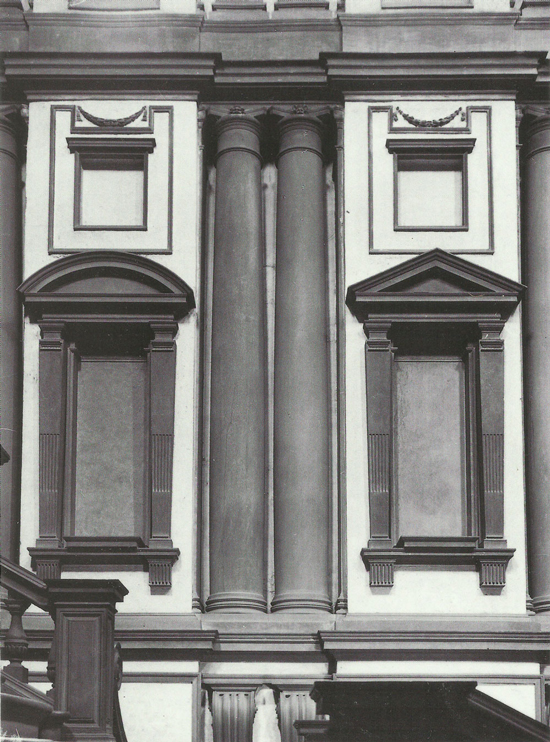
—walls not walls—
– Laurentian Library, vestibule
Michelangelo
But it is not a body: it is a library, or anyway the vestibule to a library. The portal. A library in the Renaissance is an informational space par excellence, conceived not only as a database but as an ambulatory interface[see Bibliotechical]. The library is where you organise your knowledge or understanding, not unpicking it like a thread from an inchoate knotted ball of thought, but drawing it out on the shuttle from a layered, folded, compressed, and programmed sequence of distinct yarns.
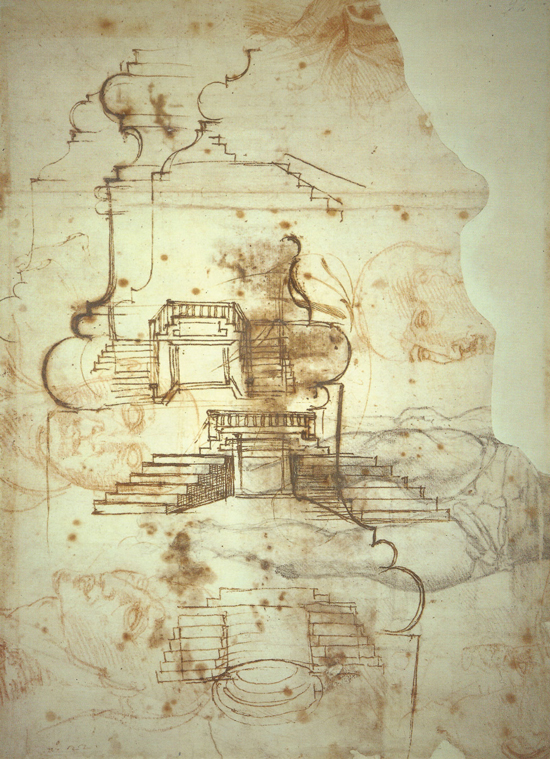
—layered, folded, compressed and programmed—
– Study for the Laurentian Library, vestibule staircase
Michelangelo
![]()
There are earlier projects—designs for the tomb of Julius II, or for the Medici chapel, not to mention the painted architecture of the Sistine Chapel—in which Michelangelo clearly considers that the function of architecture is to provide a frame for the sculptural elements. And increasingly, by some logic of association, he drew the sculpted human figures into the architectural frame itself, in the form of slaves and caryatids and herms and Telamons4.
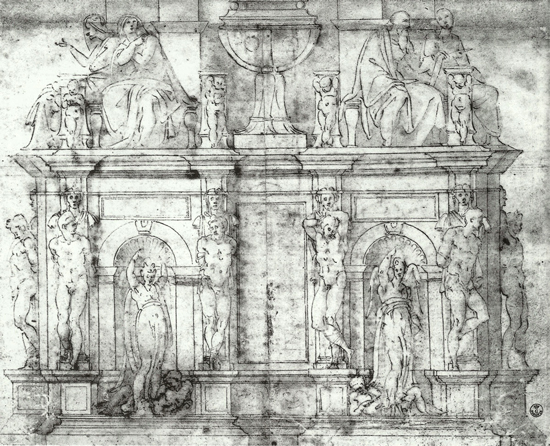
—slaves and caryatids and herms and Telamons—
– Study for the tomb of Julius II of 1513
Michelangelo
By the time of the vestibule to the Laurentian Library, those slaves and caryatids and Telamons have themselves been re-abstracted into pure architectural elements which describe or imply forces, gravity, the inner weight of things, as though the architect had embodied them, studied them, and then reassimilated them.
Only that is not quite true. For not all of those architectural elements bear weight. If the columns are abstract caryatids, they are caryatids breaking free, shucking off for a moment, partially, whatever it is they seem loaded with.
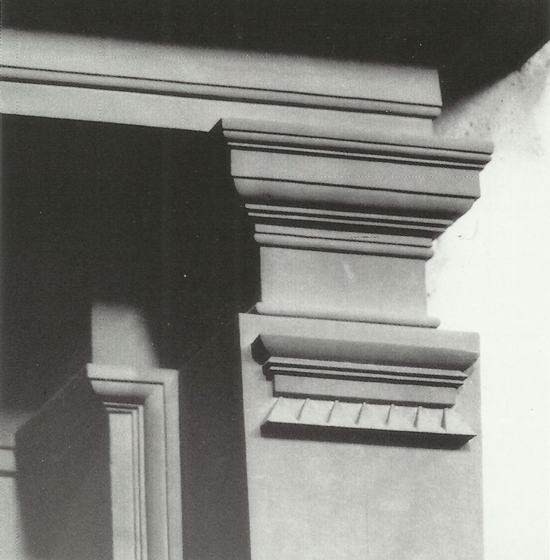
—breaking free—
– Laurentian Library, vestibule, detail
Michelangelo
What is structured here, we slowly notice, is not forces, loads, stresses, materials; or not entirely. It is rather decoration, ornament, information. A clear offset has emerged between the physical and informational structure of the building. It does one thing, says another. It resists, not weight, but, in its subtle distribution, legibility.
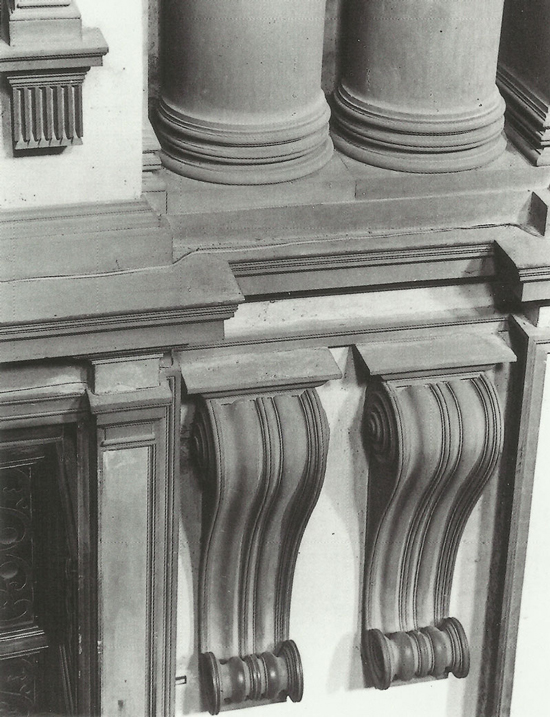
—offset—
– Laurentian Library, vestibule, detail
Michelangelo
![]()
When we are ready we carry the roof in ungainly procession by various paths to the potting shed at the rear of the garden. It is no longer a static, oblique, planar roof; rather, flapping and hinged at its ridge, it might be an essay in primitive aeronautics, a Leonardo machine aspiring to motion and the heavens.
As we stumble along, earthbound, Clarke takes issue with the dead.
He recalls for us that Hunter Sidney and he fundamentally disagreed about life and cities and their structure.
The argument, he says, went like this: are we to consider individual days as projections above the surface of life, a superstructure founded on the sub-structure of tendencies and traits and economic and social and historical determinants, just as, say, a dwelling or a car or a human being are so much interchangeable froth on the surface of the City (this was Clarke’s position); or should we imagine the relentless turnover of days (or humans, or cars, or dwellings etc.) to be the substructural element, locus of the actual passage and interplay of forces and resistance, from which emerges the intangible superstructure of a ‘life’, or ‘city’, considered as a shaped entity, a grand narrative, with its flaws and turns and resolutions. This, of course, was Hunter Sidney’s much subtler version of things.
Clarke’s position, to repeat, is that ‘life’ has no structure; there are only forces and constraints so big you cannot see them, on to which you might by an idle god be mapped but within which you control nothing.
Hunter Sidney’s version suggests a different possibility: the possibility that you might, by slightly rotating and attentively varying the pattern of your days, build or generate something new. If the superstructure is spun from the repetition of days, it follows that we can play with the salient variables of our life on a daily basis. A city, by analogy (or perhaps by structural identity) could build itself one citizen at a time. Structure, like the God of the Nasrids or the bricklayers of Brunelleschi, or the slow hours spent at the desks of the Laurentian Library, is what emerges from the repetition.
![]()
Michelangelo worked up his architectural designs in the same way that he worked up his figural masses: through a process of doodling iteration.
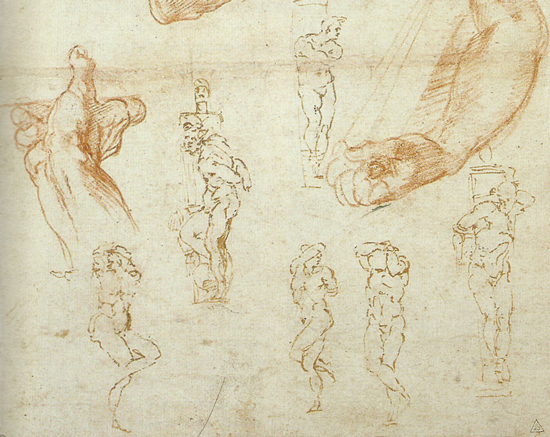
—doodling—
– mixed studies including studies for slaves for tomb of Julius II
Michelangelo
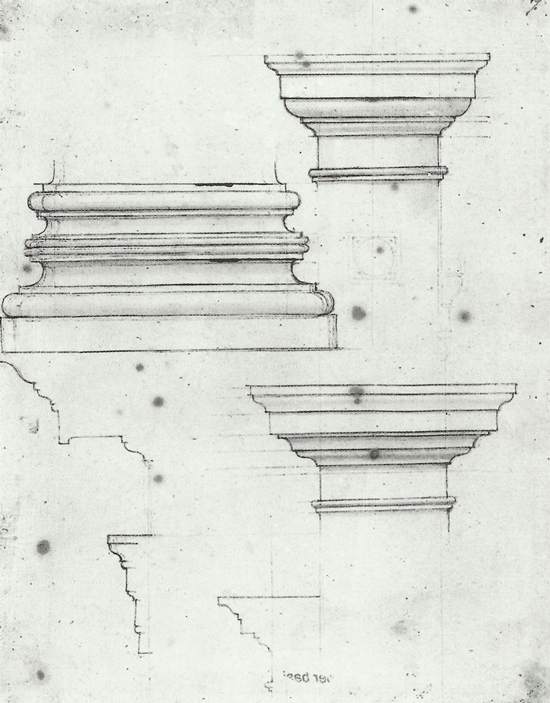
—iteration—
– studies of a base and capitals for the Laurentian Library
Michelangelo
Each line, each column profile, is susceptible of manipulation at the most detailed level. Every small twist or rotation or alteration, interacting with invisible volitions and intuitions of the hand and operating within broad contexts of intention (intention understood as a problem-solving impulse); in short, each variation circumscribes, or describes, or outlines, or at best gropes towards something which would otherwise remain, and perhaps anyway does remain, formless. Ideal forms, after all, are not formed at all, but are characterised by a sort of generative absence.
I am straying from the point, necessarily I suppose. Michelangelo’s technique is just that: a technical address built on habits of repetition and variation. What emerges from such a technique (a facade, a ceiling, a tomb, a library vestibule, a building, a Campidoglio; who knows? an Ideal City, a Norbiton) is the product not of strategy or of long vision, but of endless tinkering in the here-and-now on the materials which lie to hand, arranged around and informed by some barely-understood, perhaps unseen, organising zero of forces, which for shorthand we call life5.
![]()
When we return to the summerhouse, Mrs Isobel Easter and Veronica de Viggiani are standing with a tray of tea. As we sip and contemplate our next step, Kelley asks his wife in two words if she will be sorry to see it gone. Mrs Isobel Easter laughs and says, no, the summerhouse was always a rickety stage. By removing a moribund or redundant structural element, she implies, we can allow light and air in. Hunter Sidney’s volatile spirit, after all, will haunt this corner of the garden regardless.
She watches while we take the walls down one by one, the facade first, then the left hand wall, then the two remaining walls together. We walk each destructured plane over to the potting shed and prop it against its former opposite; disassembled, the whole building fits in a few square flat feet. Finally we return for the wooden floor and drag it up to the vertical. Insects, crawling things, disperse. Then the floor, too, takes the short walk to the potting shed.
Back at the compacted earth foundation, Veronica and Mrs Isobel Easter have started to tidy. There were bricks propping corners, some fallen bits of rotten wood. They have cleared these away and are sweeping the bare earth, uncovering like accidental archaeologists the sharp lines and dints of impression wherein you can read in negative the weight of the house. These too in time will be quickly erased.
But not now. When they are done we sit, the five of us, on the patch of unkempt grass in front of the empty space for a few minutes. We discuss possibilities for this corner of the garden, but our minds are running on the liberating absence. Bringing the summerhouse down is like bringing down an old scaffold, an intellectual or emotional support for an intellect or emotion which was no longer present. A vanished force.
We build shelters against the elemental rigours of the world, and by analogy we come to build shelters or structures of the mind within which we shelter from the rigours of existence. Its limitless expanse. Its gravity.
Brunelleschi built a cupola and it rose over Florence, not only a set of interlocking surfaces but a single volume of thought and a protection. It is no longer an articulated structure, of chains and bricks and ribs, but a metamorphosed whole. The flock was exposed but the Lord, or Brunelleschi, provided. Thus the seemingly weightless, unsupported cupola gathered itself into the airs above Florence, the diaphanous air, weighing nothing; the cupola, inside which the airs swirled.
We have no cupola now but the blue October sky; the airs which move under it and around us. What shelter we can provide will be provided by our habits of resistance. And what is that we resist? Our self-same weight, whatever it is that drags us down, constantly: fear of death, the pinch of time, the loss of people and energy, the crushing atmospheres6. But here we are, caryatids and Telamons to our own souls, released for now for a short time from our work of bearing up, just sitting on the grass.
